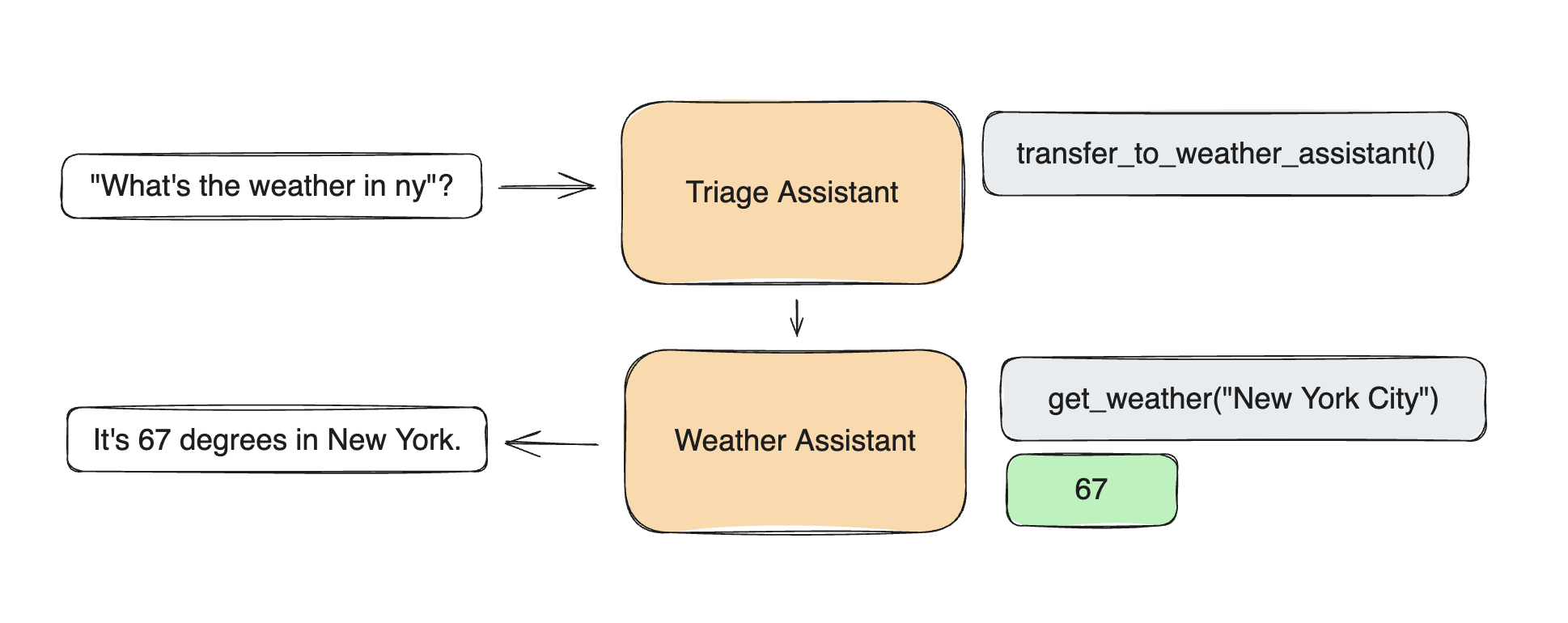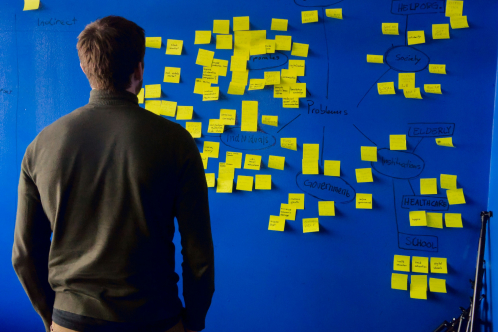The latest update in AI space: OpenAI unveils Swarm, a robust framework designed for building, orchestrating, and deploying collaborative AI agents. Moving beyond traditional single-agent models, Swarm enables multiple AI agents to interact and work together, each contributing specific skills to solve complex tasks more efficiently. This approach positions Swarm as a highly suitable tool for specialized use cases in complex simulations, large-scale data analysis, and dynamic problem-solving.
From the tech perspective, this platform enables developers to implement so-called “routines” and “handoffs,” which allow agents to work collaboratively on complex tasks by splitting responsibilities and efficiently handing off processes between agents. For instance, a “triage agent” might redirect customer inquiries to agents specializing in sales or support, enhancing both speed and relevance in responses. In this piece, we’ll overview how all the things work and what outcomes the Swarm promises to organizations.
Multi-Agent Collaboration Redefined
Unlike single-agent APIs and models, Swarm allows agents to share tasks and communicate dynamically. This distributed model means that tasks can be broken down and handled simultaneously by various agents, enhancing productivity and enabling more sophisticated problem-solving. OpenAI Swarm thus stands apart from other OpenAI tools, such as Custom GPTs or API Assistants, which are primarily designed for single-agent, sequential processing.
Key Features of OpenAI Swarm
- Orchestration and Task Delegation
Swarm’s orchestration capabilities ensure that each agent works in harmony with others. Task delegation, synchronization, and aggregation are managed seamlessly, allowing developers to create scalable AI solutions tailored to complex requirements. - Scalability and Flexibility
OpenAI Swarm supports adding specialized agents on demand, facilitating a flexible approach to scaling. Each agent can be customized for particular roles within a task, making Swarm an adaptable solution for various industry needs, including healthcare, finance, and large-scale data projects. - Node.js Implementation with Swarm.js
With Swarm.js, a lightweight SDK for Node.js, OpenAI brings Swarm’s capabilities to the JavaScript ecosystem, allowing developers to use Swarm’s API efficiently. Swarm.js simplifies creating, managing, and coordinating multiple agents, paving the way for scalable, real-world applications that leverage multi-agent orchestration.

The SWARM logic described on official OpenAI GitHub.
Practical Applications and Future Potential
First of all, Swarm is designed for back-end integration, offering powerful options for companies looking to implement multi-agent AI models in their systems. Its ability to orchestrate specialized agents is ideal for projects requiring high-level computation, such as simulations and ERP systems.
As an experimental approach for multi-agents environments, OpenAI Swarm shows significant potential across industries where complex, distributed tasks benefit from parallel processing and specialized agents. Here’s a look at some industry applications:
- Healthcare
In healthcare, multi-agent systems powered by Swarm can facilitate large-scale patient data analysis, predictive modeling, and even real-time patient monitoring. For example, multiple agents can handle diverse medical records, from imaging to genetic data, to generate insights more efficiently than traditional systems. - Financial Services
The finance industry can leverage Swarm’s orchestration for fraud detection, risk assessment, and customer service automation. Each agent within Swarm can specialize in monitoring specific financial metrics or regulatory compliance areas, making it a robust choice for high-stakes, detail-oriented tasks. - E-Mobility and Smart Cities
Swarm is positioned to impact e-mobility, with applications in managing autonomous fleets, traffic control systems, and urban infrastructure. By coordinating specialized agents for tasks like traffic prediction, route optimization, and energy management, Swarm enables smart, interconnected urban planning. - Customer Support and Personalization
With multiple agents handling different aspects of customer interaction, companies can offer a level of personalized service beyond what single-agent models achieve. For instance, in e-commerce, one agent could analyze past purchases to make product recommendations while another assists with order tracking. This coordinated approach can lead to smoother, more engaging customer experiences. - Data Analysis
Data-intensive industries, including finance and logistics, benefit significantly from Swarm’s ability to deploy agents with specialized analytical roles. Multi-agent setups allow for real-time data processing and interpretation, transforming raw data into actionable insights more rapidly. For example, in logistics, agents might track inventory, analyze transit times, and optimize delivery routes simultaneously, facilitating just-in-time operations. - IoT and Smart Manufacturing
In the context of IoT and smart manufacturing, Swarm can open collaborative processing among numerous devices and sensors, automating responses to dynamic conditions on the factory floor. With multiple agents handling quality control, machine status monitoring, and workflow adjustments, Swarm-based systems contribute to reduced downtime and more agile production capabilities.
OpenAI Swarm’s Role in Advancing AI Development and Research
OpenAI Swarm opens new avenues for advanced AI development, particularly in areas that demand intricate task coordination, autonomous decision-making, and adaptive workflows. By enabling multiple agents to collaborate, Swarm fosters AI systems that can handle dynamic environments and complex processes more effectively. For research institutions and tech companies, this multi-agent approach provides a sandbox for testing the limits of autonomous systems in real-world scenarios.
- Research and Development
OpenAI Swarm is ideal for R&D initiatives, as it allows developers to simulate, test, and optimize the interactions between multiple agents. For example, AI researchers can experiment with machine learning models that benefit from distributed processing, exploring how agents can communicate, share resources, and evolve as a team. - Innovation in Multi-Agent Ecosystems
Swarm promotes innovations by allowing developers to assign specialized roles to each agent. This capability encourages experimentation, whether for optimizing logistics, improving robotic swarm intelligence, or testing autonomous decision-making in diverse environments. Swarm’s versatility enables AI labs and research institutions to push the boundaries of multi-agent systems and find new applications across industries.
Getting Started with OpenAI Swarm
Developers interested in leveraging Swarm can experiment with Swarm.js in Node.js or explore Python frameworks directly through OpenAI’s API. As Swarm continues to evolve, it promises to expand its role in AI-driven innovation, supporting diverse industries and complex operational needs.
For more details on Swarm’s architecture and potential applications, explore the initial insights shared in the OpenAIDeveloper Forum.
For those seeking a deeper dive into the architecture and applications of OpenAI Swarm, this YouTube video provides an accessible overview of Swarm’s capabilities in orchestrating multi-agent systems. The video unpacks the technical workings of Swarm, discussing how it supports coordinated, real-time interactions among agents to tackle sophisticated tasks that would challenge single-agent setups.
The 5 Pillars of Implementing a Successful AI Strategy in 2025
Transitioning into a data-driven organization is not a final destination, but a journey. Get the complete picture of building for the future, the challenges you may face and overcoming them to find business success
Implementing Swarm in Existing Business Ecosystems
Integrating OpenAI Swarm into an existing business infrastructure involves careful consideration of each agent’s role and the specific tasks it will address. Successful implementations require a structured setup where agents can efficiently collaborate without redundant task overlap. Here’s a step-by-step breakdown:
- Define Agent Roles
Start by determining the specific tasks each agent will handle. In finance, for instance, one agent might monitor market trends, while another handles transaction risk assessment. This clear division enables Swarm agents to operate seamlessly, contributing to a cohesive output. - Set Up Communication Protocols
Swarm relies on effective communication between agents, using API calls and internal messaging to share data and updates. Businesses can implement these protocols to ensure real-time data exchange, allowing agents to make informed decisions. - Monitor and Optimize
After initial implementation, continuous monitoring ensures that agents are performing as expected. Developers can leverage Swarm’s flexible structure to tweak agent parameters, reassign tasks, or scale up agent resources to meet increasing demands.
Practical Insights and Future Prospects
OpenAI Swarm is still evolving, and as more businesses adopt it, its applications and best practices will expand. This growth presents valuable insights for companies seeking to leverage AI-driven innovation within multi-agent frameworks. OpenAI’s community is actively engaging with Swarm, sharing insights and developments, including in discussions like the OpenAI Developer Forum, where use cases and integration techniques are explored in-depth
In the coming years, OpenAI Swarm is likely to see advancements in agent autonomy, improved orchestration techniques, and expanded support for various programming environments, making it an adaptable tool for AI-driven projects across diverse sectors.
Navigating Challenges in Multi-Agent Systems
Multi-agent orchestration brings powerful advantages but also some challenges typical of distributed systems. Businesses and developers need to consider these aspects to leverage Swarm’s full potential effectively:
- Scalability Management
As the number of agents in a Swarm system grows, so does the complexity of managing interactions and resource allocations. Over time, businesses will need to fine-tune their Swarm infrastructure to ensure that the benefits of multi-agent collaboration outweigh the costs of increased computational demands. - Inter-Agent Dependencies
One of the most unique challenges with Swarm is managing dependencies between agents. When one agent’s output is another’s input, the timing and accuracy of data exchange are critical. Swarm’s orchestration capabilities allow for synchronization, but teams must still create robust protocols to handle issues such as delays or conflicting data inputs. - Security and Data Privacy
In a system where multiple agents process and share sensitive data, security and privacy controls become essential. Developers should implement safeguards to ensure that data exchanged between agents remains protected, especially in sensitive industries like healthcare and finance. Encrypting communications and restricting agent access to specific data points are best practices for maintaining privacy within Swarm systems.
Sphere and Swarm: The Early-bird chance
For companies looking to implement Swarm in a production environment, Sphere’s extensive AI and multi-agent systems expertise provides the ideal foundation. Our experience in AI-based transformation and multi-agent frameworks enables businesses to deploy Swarm ahead of others, creating systems that truly work.
As an open-source project, Swarm holds tremendous potential for community-led development. According to OpenAI, new use cases and experimental integrations are continuously emerging, and we encourage you to explore and apply it to your unique use case.





